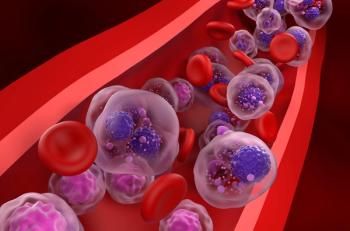
Ensuring a Welcoming Facility Is Vital to Maintaining the Health of LGBTQ Patients with Cancer
Lesbian, gay, bisexual, transgender, and queer (LGBTQ) patients with cancer face specific barriers when seeking medical care, but pharmacists and other medical professionals can take specific steps to reduce the gaps in care.
Lesbian, gay, bisexual, transgender, and queer (LGBTQ) patients with cancer face specific barriers when seeking medical care, but pharmacists and other medical professionals can take specific steps to reduce the gaps in care, according to a session on Wednesday at the Hematology/Oncology Pharmacy Association Annual Conference.
In a survey of more than 800 LGBTQ people, approximately 10% experienced refusal of medical services, refusal to recognize a partner and/or children in a medical environment, harsh or abusive language from medical professionals, and unwanted physical contact by a physician, according to presenter Calvin Daniels, PharmD, PhD, BCPPS, a clinical pharmacist at St. Jude Children’s Research Hospital.
Daniels said that many LGBTQ patients avoid medical environments as a result of these experiences, leading to missed diagnosis opportunities and worsening health outcomes. The first step to improving these experiences, Daniels said, is understanding some key facts about the community and your patients individually.
When discussing health history with a patient, Daniels said asking for their preferred name and pronouns is vital. Medical professionals should advocate for their electronic health form to include this information, but even if they do not, professionals should ask the patient and make note of their answer.
Based on their responses, LGBTQ patients need more specific screenings based on higher health risks. For men who have sex with men, for example, Daniels said physicians may want to screen for HIV, syphilis, gonorrhea, and chlamydia. Similarly, those using injected drugs or off-market hormonal therapy should be screened for hepatitis C. Understanding the increased risks for some LGBTQ patients is vital in order to make decisions about testing, diagnosing and treating some conditions.
In addition to understanding the medical risks faced by some LGBTQ patients, Daniels said, it is vital for medical professionals to understand that “coming out” is an evolving process that has benefits as well as risks. The ability to be open about their sexual or gender identify allows patients to bring their “whole selves” to appointments, Daniels said, which can improve outcomes. At the same time, however, risks for “out” patients include increased stress and fear, which can negatively affect health outcomes.
Daniels also pointed out that patients may inform their physician or other medical professionals of their identity but may not be public about these facts. For that reason, it is vital for providers to be intentional and conscious about their surroundings.
“Think of it along the same lines as [the Health Insurance Portability and Accountability Act],” Daniels said. “You would not want to discuss private information in the waiting room or where others could overhear.”
A key example of information to be cautious about vocalizing is the patient’s preferred name. Daniels urged attendees to ask for and use LGBTQ patients’ preferred names during appointments, but to be cautious about calling them by that name in the waiting room or other public settings.
It is especially important to be conscientious when dealing with LGBTQ pediatric patients, Daniels added. In addition to the same risks faced by LGBTQ adults, pediatric patients may face more mental health issues, bullying, and harassment. Daniels pointed out that up to 40% of homeless youth identified as LGBTQ.
It is vital to maintain the confidentiality of the patient when it comes to their LGBTQ identity, Daniels said, especially as it relates to parental disclosure. For parents who do know about their child’s sexual or gender identity, it may be difficult for them to accept the decision. Daniels said clinicians should acknowledge their feelings but provide support and resources for the patient who has disclosed their identity.
Daniels also pointed out that gender affirming care for transgender pediatric patients is endorsed by the American Academy of Pediatrics, the American Medical Association, and the American Psychiatric Association. Furthermore, he said, reparative or conversion therapies and delayed gender transitions can have serious negative consequences, including suicidal thoughts and self-harm.
In addition to improving the experiences for LGBTQ patients, Daniels said creating a more inclusive environment can be important for LGBTQ staff as well.
In a survey of LGBTQ clinicians, Daniels said that 33% of medical students planned to disclose their identity during the residency application process, but that 60% were concerned they would not be accepted because of their identity. Furthermore, in a survey of practicing LGBTQ physicians, 65% heard derogatory comments, 27% witnessed discriminatory treatment of a colleague, and 15% had been harassed by a colleague.
Making a positive change for patients leads to a positive change for clinicians and other staff, Daniels said. He concluded with several recommendations, including displaying rainbow flag stickers, lanyards, or pins; providing training to staff and workers on LGBTQ-affirming care; and asking every patient their preferred name and pronouns. If you accidentally use an incorrect name or pronoun, Daniels said, just apologize and continue.
“Just apologize, say you know what their name or pronouns are, and keep moving with patient care,” Daniels said. “That’s the most important thing.”
REFERENCE
Daniels C. Cancer Patients in the LGBTQ Community. Presented at: HOPA 2020 Annual Meeting; Tampa, FL: March 11, 2020.
Newsletter
Stay informed on drug updates, treatment guidelines, and pharmacy practice trends—subscribe to Pharmacy Times for weekly clinical insights.








































































































































































































